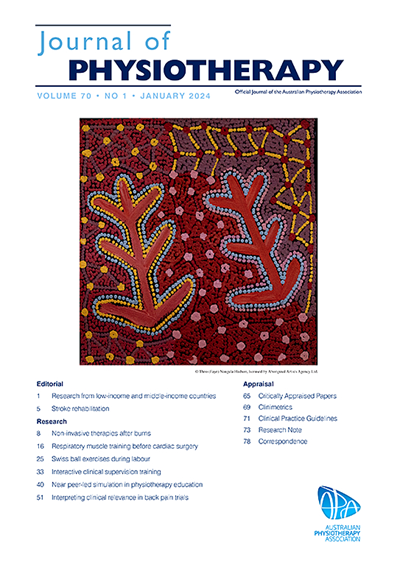高强度和低强度普拉提对慢性非特异性腰痛患者的疼痛和残疾有相似的影响:一项随机试验。
IF 9.7
1区 医学
Q1 ORTHOPEDICS
引用次数: 0
摘要
问题:对于慢性非特异性腰痛患者,与低强度普拉提运动相比,高强度普拉提运动对疼痛、残疾、患者特异性功能、运动恐惧症和髋部等长肌力的影响是什么?设计:随机试验,隐蔽分配,盲法评估和意向治疗分析。参与者:168名慢性非特异性腰痛患者,年龄在18至60岁之间。干预措施:参与者被分配进行1小时的临床普拉提,高强度或低强度,每周两次,持续6周。结果测量:在6周的干预期结束时,主要结果是数值疼痛量表和Roland Morris残疾问卷。次要结果是患者特异性功能量表、运动恐惧症的坦帕量表和6周时的等长髋关节力量。在干预6个月和12个月后重新测量疼痛和残疾。结果:两种普拉提方案在干预期结束时对所有结果的影响差异可以忽略不计。在6个月和12个月时,组间疼痛强度的差异仍然可以忽略不计,但与高强度普拉提相比,低强度普拉提的估计置信区间从没有影响到有价值的获益(≥1.4):6个月的MD为0.6 (95% CI为-0.2至1.4),12个月的MD为0.8 (95% CI为0.0至1.6)。在6个月和12个月时对残疾的影响仍然可以忽略不计。低强度组的不良事件较少:绝对风险降低0.20 (95% CI 0.10 ~ 0.31)。结论:高强度和低强度普拉提对慢性非特异性腰痛患者的疼痛、残疾和其他结果的影响非常相似。物理治疗师应该支持低强度普拉提运动来治疗慢性非特异性腰痛,因为大多数结果的效果与高强度普拉提运动非常相似,但副作用更少。注册:RBR-2d2vb9。本文章由计算机程序翻译,如有差异,请以英文原文为准。
High-intensity and low-intensity Pilates have similar effects on pain and disability in people with chronic non-specific low back pain: a randomised trial
Question
In people with chronic non-specific low back pain, what is the effect of high-intensity Pilates exercise compared with low-intensity Pilates exercise on pain, disability, patient-specific function, kinesiophobia and isometric hip strength?
Design
Randomised trial with concealed allocation, blinded assessors and intention-to-treat analysis.
Participants
One hundred and sixty-eight people with chronic non-specific low back pain and aged between 18 and 60 years.
Interventions
Participants were allocated to undertake 1-hour sessions of clinical Pilates at either high-intensity or low-intensity, twice per week for 6 weeks.
Outcome measures
The primary outcomes were the numerical pain scale and the Roland Morris Disability Questionnaire at the end of the 6-week intervention period. The secondary outcomes were the Patient-Specific Functional Scale, the Tampa Scale for Kinesiophobia and isometric hip strength at 6 weeks. Pain and disability were also re-measured 6 and 12 months after the intervention.
Results
The two Pilates regimens had negligible differences in effects on all outcomes at the end of the intervention period. At 6 and 12 months, the between-group differences in pain intensity were still negligible but the confidence intervals around those estimates spanned from around no effect to a worthwhile benefit (≥ 1.4) from low-intensity Pilates compared with high-intensity Pilates: 6-month MD 0.6 (95% CI –0.2 to 1.4) and 12-month MD 0.8 (95% CI 0.0 to 1.6). The effect on disability remained negligible at 6 and 12 months. Adverse events were less common in the low-intensity group: absolute risk reduction 0.20 (95% CI 0.10 to 0.31).
Conclusion
High-intensity and low-intensity Pilates had very similar effects on pain, disability and other outcomes in people with chronic non-specific low back pain. Physiotherapists should endorse low-intensity Pilates exercises for managing chronic non-specific low back pain because the effects on most outcomes are very similar to high-intensity Pilates exercise but there are fewer side effects.
Registration
RBR-2d2vb9.
求助全文
通过发布文献求助,成功后即可免费获取论文全文。
去求助
来源期刊

Journal of Physiotherapy
ORTHOPEDICS-REHABILITATION
CiteScore
11.40
自引率
7.40%
发文量
69
审稿时长
72 days
期刊介绍:
The Journal of Physiotherapy is the official journal of the Australian Physiotherapy Association. It aims to publish high-quality research with a significant impact on global physiotherapy practice. The journal's vision is to lead the field in supporting clinicians to access, understand, and implement research evidence that will enhance person-centred care. In January 2008, the Journal of Physiotherapy became the first physiotherapy journal to adhere to the ICMJE requirement of registering randomized trials with a recognized Trial Registry. The journal prioritizes systematic reviews, clinical trials, economic analyses, experimental studies, qualitative studies, epidemiological studies, and observational studies. In January 2014, it also became the first core physiotherapy/physical therapy journal to provide free access to editorials and peer-reviewed original research. The Australian Physiotherapy Association extended their support for excellence in physiotherapy practice by sponsoring open access publication of all Journal of Physiotherapy content in 2016. As a result, all past, present, and future journal articles are freely accessible, and there are no author fees for publication.
 求助内容:
求助内容: 应助结果提醒方式:
应助结果提醒方式:


